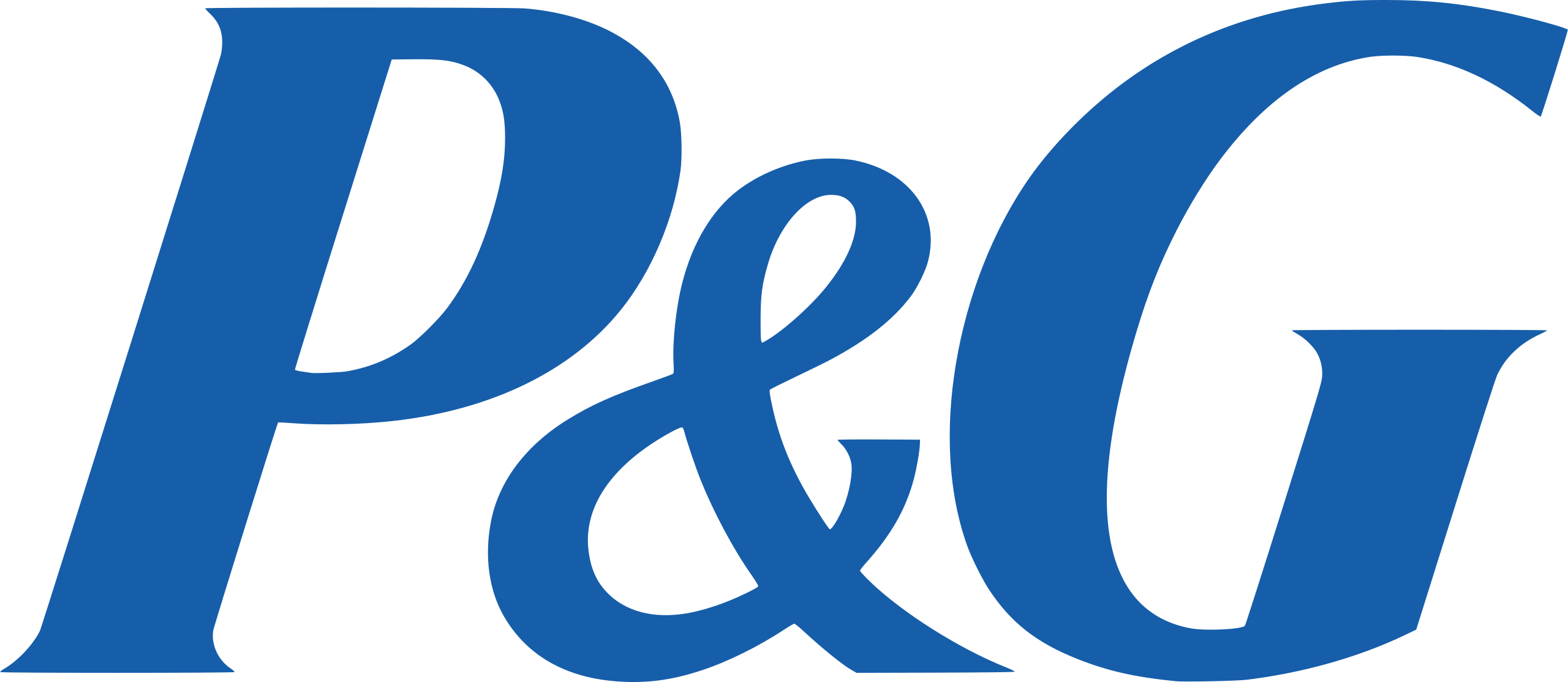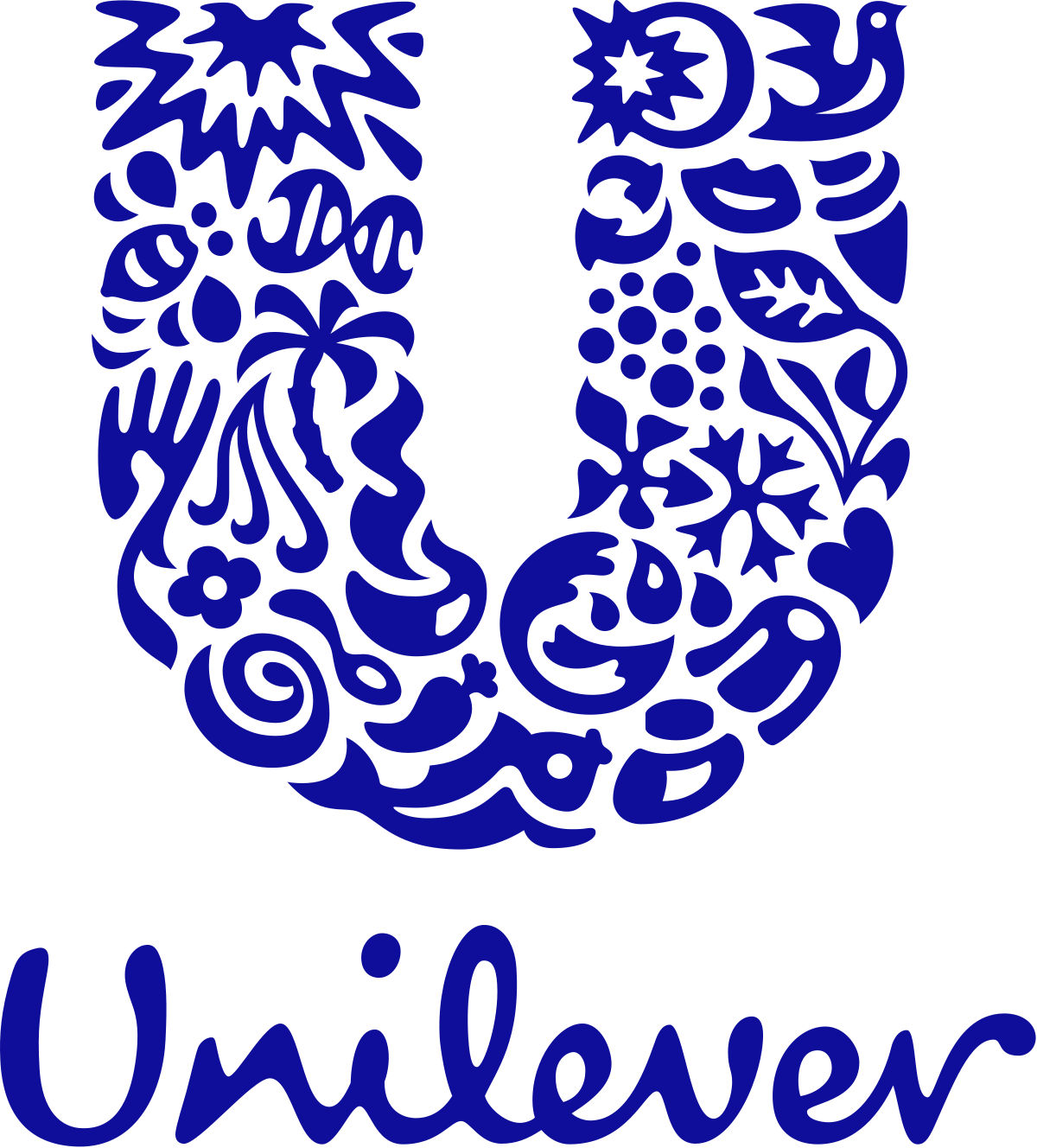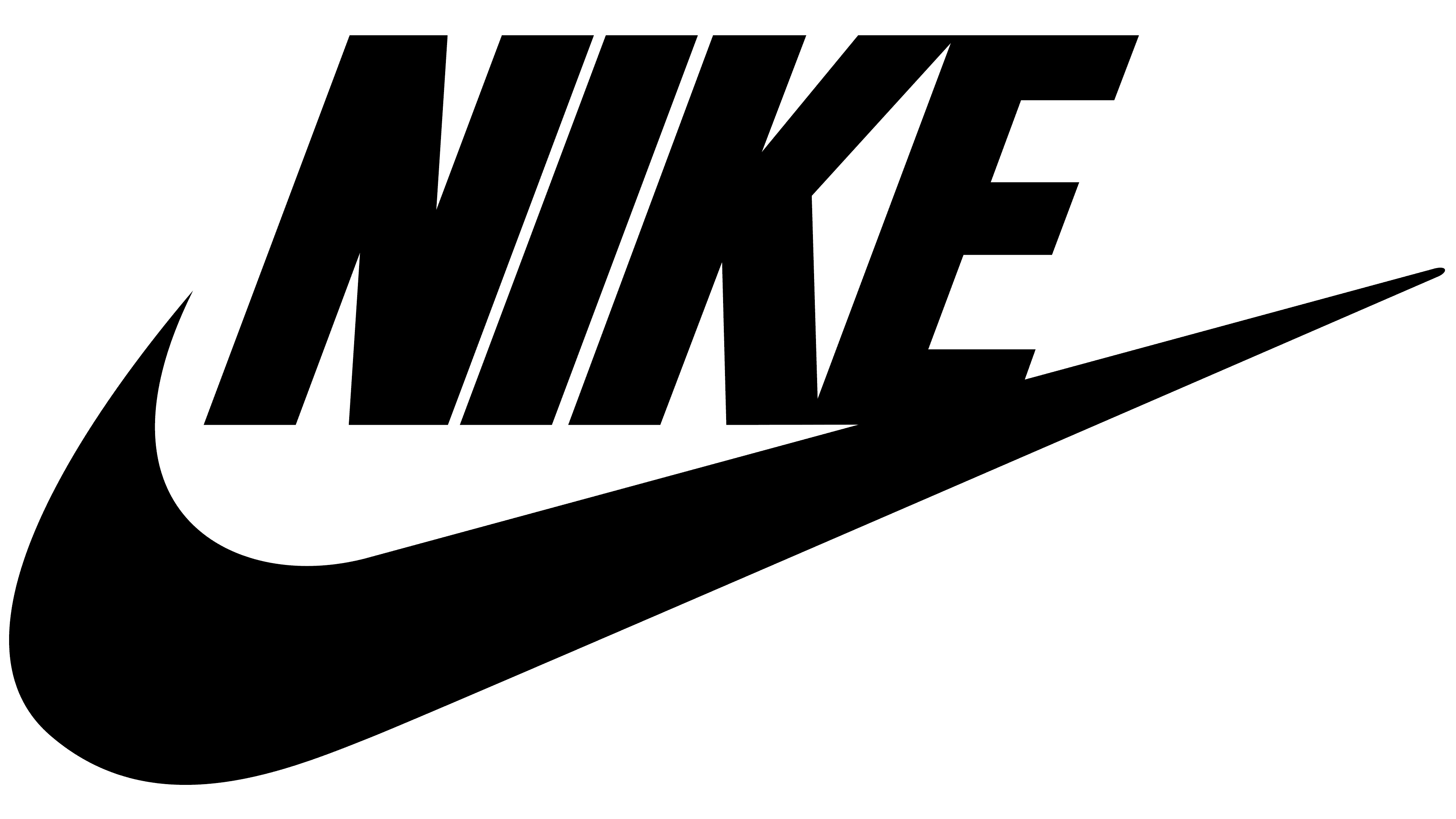Global Luxury Perfume Market, By Fragrance Type, By Intensity, By End User, By Sales Channel, By Region & Segmental Insights Trends and Forecast, 2024 – 2034
- Industry: Consumer Goods
- Report ID: TNR-110-1123
- Number of Pages: 420
- Table/Charts : Yes
- June, 2024
- Base Year : 2024
- No. of Companies : 10+
- No. of Countries : 29
- Views : 10277
- Covid Impact Covered: Yes
- War Impact Covered: Yes
- Formats : PDF, Excel, PPT
Luxury perfumes are high-end fragrances crafted from premium ingredients, often associated with prestigious brands and exclusivity. The overall luxury perfume market encompasses a wide array of scents catering to discerning consumers seeking sophistication and distinction. This segment thrives on exclusivity, craftsmanship, and brand reputation, offering unique olfactory experiences.
Several factors drive the growth of the luxury perfume market. The rising disposable incomes of affluent consumers fuel demand for premium products, including fragrances. Additionally, the growing preference for personalized and niche scents contributes to market expansion. Strategic marketing initiatives, celebrity endorsements, and innovative packaging enhance brand visibility and consumer appeal. The allure of luxury perfumes lies in their ability to evoke emotions, reflect individuality, and signify status, making them a coveted indulgence in the global fragrance landscape. In Terms of Revenue, the Global Luxury Perfume Market was Worth US$ 14.8 Bn in 2023, Anticipated to Witness CAGR of 6.8% During 2024 – 2034.
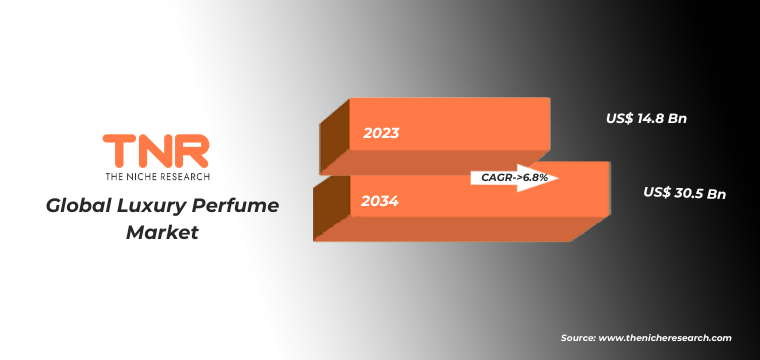
Trends in the Global Luxury Perfume Market
- Sustainability Integration: One prominent trend in the global luxury perfume market is the increasing integration of sustainability practices. Luxury perfume brands are adopting eco-friendly sourcing methods, utilizing biodegradable packaging, and committing to reducing carbon footprints. Consumers are becoming more conscious of environmental impact, driving demand for ethically sourced ingredients and eco-conscious production processes. Brands embracing sustainability not only appeal to environmentally aware consumers but also align with evolving societal values, fostering brand loyalty and differentiation in the competitive luxury fragrance market.
- Customization and Personalization: Luxury brands are offering bespoke fragrance experiences, allowing customers to create unique scents tailored to their preferences. From selecting individual notes to designing personalized packaging, consumers crave a sense of exclusivity and self-expression. This trend reflects the desire for unique, one-of-a-kind experiences in a world saturated with mass-produced goods. Customized perfumes not only cater to individual tastes but also provide a deeper connection between the consumer and the brand, driving engagement and brand loyalty in the luxury fragrance market.
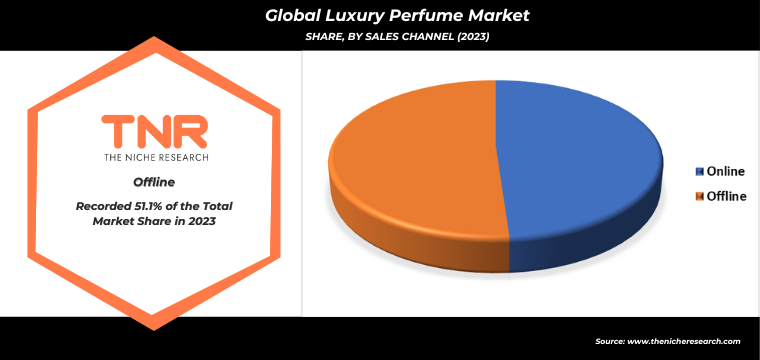
The Oriental fragrance category has emerged as a dominant force in the global luxury perfume market, captivating a significant share of consumers worldwide. Characterized by opulent and exotic notes such as spices, resins, amber, and precious woods, Oriental fragrances evoke a sense of sensuality, mystery, and sophistication. Renowned for their depth, warmth, and complexity, these scents appeal to individuals seeking alluring and indulgent olfactory experiences. The allure of Oriental fragrances lies in their ability to transport wearers to distant lands and evoke rich cultural narratives, making them timeless and captivating. With a growing appreciation for the exotic and luxurious, Oriental perfumes continue to captivate discerning consumers, contributing significantly to the thriving global luxury perfume market.
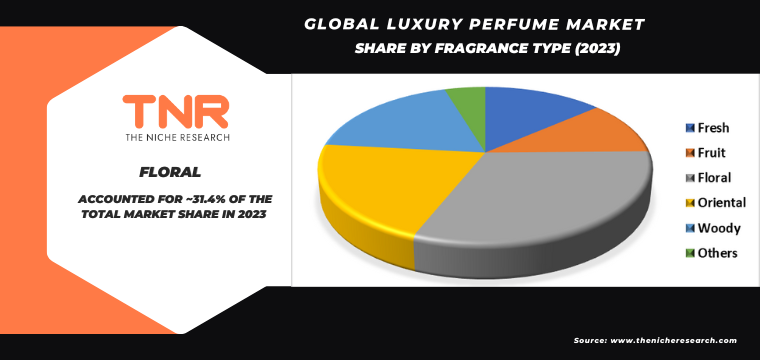
In 2023, the eau de toilette (EDT) segment, classified by intensity, solidified its position as the second-largest category in the global luxury perfume market.
Eau de toilette, renowned for its balanced concentration of fragrance oils, offers a lighter and more refreshing scent compared to its counterparts, eau de parfum (EDP) and parfum. This segment appeals to a broad spectrum of consumers, from those seeking subtle everyday fragrances to individuals preferring a more moderate scent projection for various occasions. The rise of the EDT segment underscores a shift in consumer preferences towards fragrances that strike a harmonious balance between longevity and freshness. With its versatile appeal and accessibility, EDT continues to carve out a significant market share, contributing to the overall growth and diversification of the luxury perfume market.
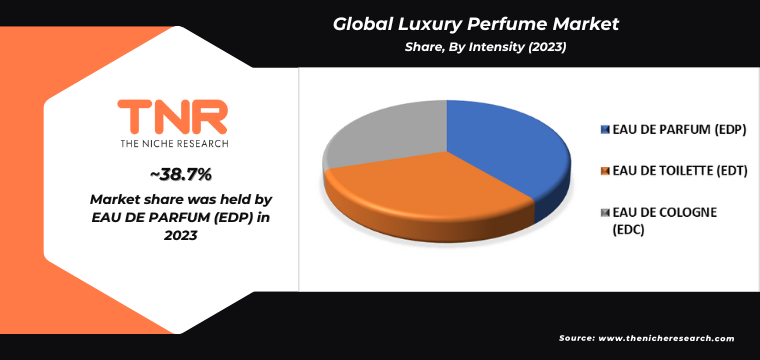
Women’s segment, categorized by end-user preference, has exerted significant dominance over the global luxury perfume market. Women’s fragrances represent a diverse array of scents tailored to cater to various tastes, moods, and occasions. Renowned for their elegance, sophistication, and femininity, luxury perfumes designed for women encapsulate a spectrum of olfactory experiences, from floral and fruity to oriental and woody compositions. This segment’s supremacy reflects the enduring appeal of luxury fragrances as a form of self-expression and indulgence among female consumers worldwide. With a blend of tradition and innovation, brands continually strive to captivate women with captivating scents encased in exquisite packaging, fostering brand loyalty and establishing a stronghold in the fiercely competitive luxury perfume market.
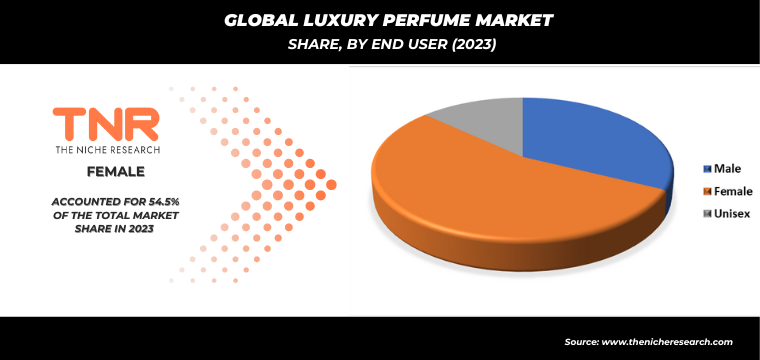
In 2023, North America solidified its dominance in the global luxury perfume market, emerging as a key powerhouse driving the industry’s growth and innovation.
The region’s affluent consumer base, coupled with a strong culture of luxury consumption, contributed to its leading position. North American consumers exhibit a penchant for premium fragrances, drawn to a wide array of scents ranging from timeless classics to niche and artisanal creations. Moreover, the region’s robust retail infrastructure, including high-end department stores, boutiques, and online platforms, provides ample opportunities for luxury perfume brands to showcase their offerings and connect with discerning customers. With a penchant for luxury and a discerning taste for quality, North America continues to play a pivotal role in shaping the trends and dynamics of the global luxury perfume market.
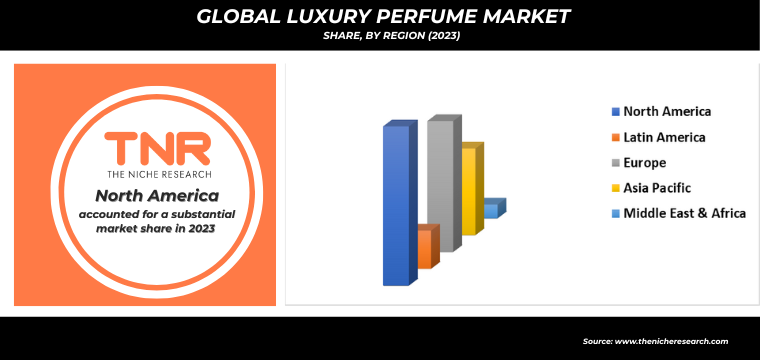
Competitive Landscape
Some of the players operating in the luxury perfume market are
- Burberry Group PLC
- Chanel SA
- Compagnie Financiere Richemont SA
- Coty Inc.
- Estee Lauder Companies Inc.
- Hermes International SA
- Kering SA
- LVMH Moet Hennessy Louis Vuitton
- Prada Holding SpA
- Ralph Lauren Corporation
- Other Industry Participants
Global Luxury Perfume Market Scope
| Report Specifications | Details |
| Market Revenue in 2023 | US$ 14.8 Bn |
| Market Size Forecast by 2034 | US$ 30.5 Bn |
| Growth Rate (CAGR) | 6.8% |
| Historic Data | 2016 – 2022 |
| Base Year for Estimation | 2023 |
| Forecast Period | 2024 – 2034 |
| Report Inclusions | Market Size & Estimates, Market Dynamics, Competitive Scenario, Trends, Growth Factors, Market Determinants, Key Investment Segmentation, Product/Service/Solutions Benchmarking |
| Segments Covered | By Fragrance Type, By Intensity, By End User, By Sales Channel, By Region |
| Regions Covered | North America, Europe, Asia Pacific, Middle East & Africa, Latin America |
| Countries Covered | U.S., Canada, Mexico, Rest of North America, France, The UK, Spain, Germany, Italy, Nordic Countries (Denmark, Finland, Iceland, Sweden, Norway), Benelux Union (Belgium, The Netherlands, Luxembourg), Rest of Europe, China, Japan, India, New Zealand, Australia, South Korea, Southeast Asia (Indonesia, Thailand, Malaysia, Singapore, Rest of Southeast Asia), Rest of Asia Pacific, Saudi Arabia, UAE, Egypt, Kuwait, South Africa, Rest of Middle East & Africa, Brazil, Argentina, Rest of Latin America |
| Key Players | Burberry Group PLC, Chanel SA, Compagnie Financiere Richemont SA, Coty Inc., Estee Lauder Companies Inc., Hermes International SA, Kering SA, LVMH Moet Hennessy Louis Vuitton , Prada Holding SpA, Ralph Lauren Corporation |
| Customization Scope | Customization allows for the inclusion/modification of content pertaining to geographical regions, countries, and specific market segments. |
| Pricing & Procurement Options | Explore purchase options tailored to your specific research requirements |
| Contact Details | Consult With Our Expert
Japan (Toll-Free): +81 663-386-8111 South Korea (Toll-Free): +82-808- 703-126 Saudi Arabia (Toll-Free): +966 800-850-1643 United Kingdom: +44 753-710-5080 United States: +1 302-232-5106 E-mail: askanexpert@thenicheresearch.com
|
Global Luxury Perfume Market
By Fragrance Type
- Fresh
- Fruit
- Floral
- Oriental
- Woody
- Others
By Intensity
- EAU DE PARFUM (EDP)
- EAU DE TOILETTE (EDT)
- EAU DE COLOGNE (EDC)
By End User
- Male
- Female
- Unisex
By Sales Channel
- Online
- Offline
- Supermarkets
- Specialty stores
- Departmental stores
- Others
By Region
- North America (U.S., Canada, Mexico, Rest of North America)
- Europe (France, The UK, Spain, Germany, Italy, Nordic Countries (Denmark, Finland, Iceland, Sweden, Norway), Benelux Union (Belgium, The Netherlands, Luxembourg), Rest of Europe)
- Asia Pacific (China, Japan, India, New Zealand, Australia, South Korea, Southeast Asia (Indonesia, Thailand, Malaysia, Singapore, Rest of Southeast Asia), Rest of Asia Pacific)
- Middle East & Africa (Saudi Arabia, UAE, Egypt, Kuwait, South Africa, Rest of Middle East & Africa)
- Latin America (Brazil, Argentina, Rest of Latin America)
Report Layout:
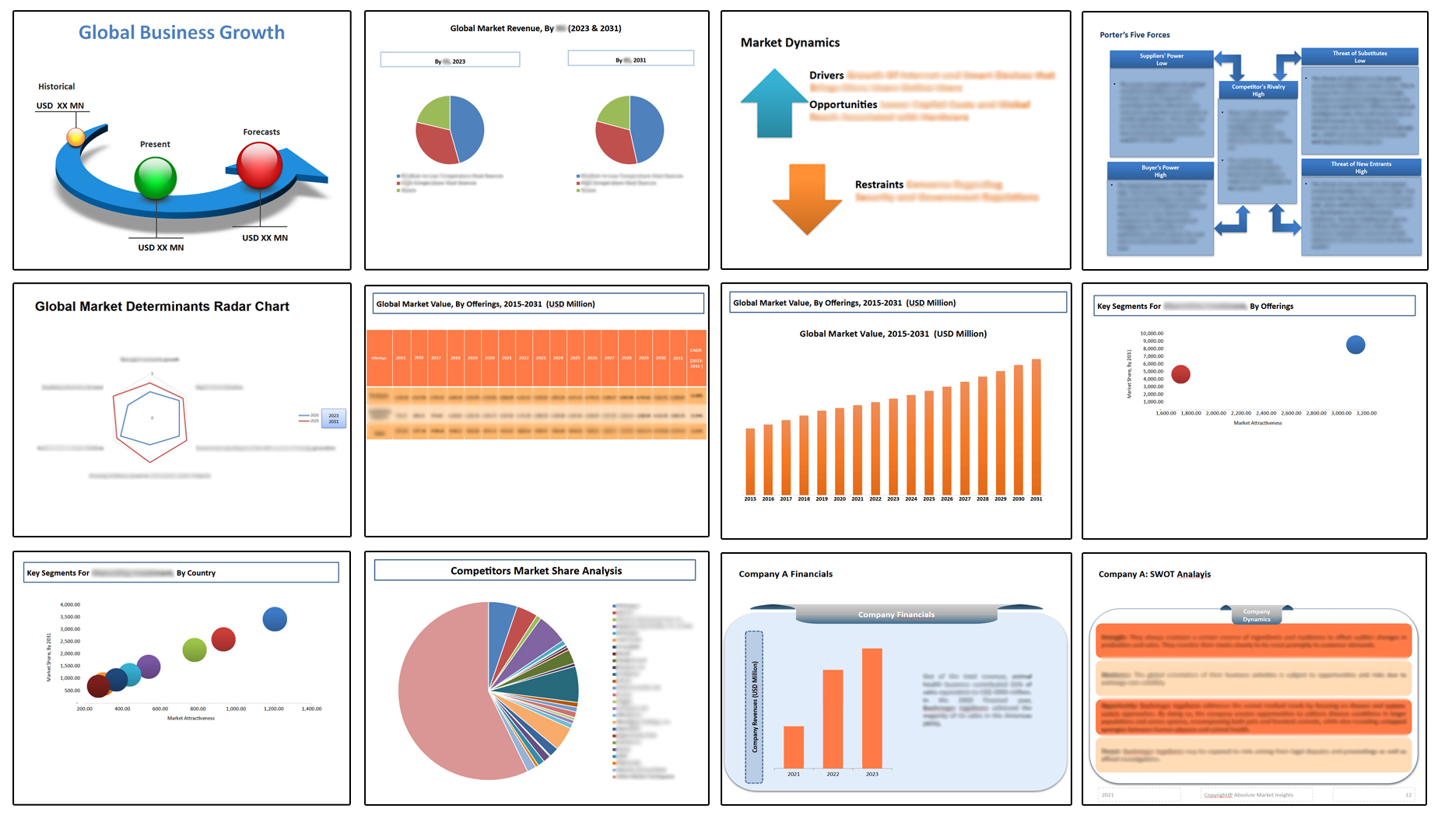
Table of Contents
Note: This ToC is tentative and can be changed according to the research study conducted during the course of report completion.
**Exclusive for Multi-User and Enterprise User.
Global Luxury Perfume Market
By Fragrance Type
- Fresh
- Fruit
- Floral
- Oriental
- Woody
- Others
By Intensity
- EAU DE PARFUM (EDP)
- EAU DE TOILETTE (EDT)
- EAU DE COLOGNE (EDC)
By End User
- Male
- Female
- Unisex
By Sales Channel
- Online
- Offline
- Supermarkets
- Specialty stores
- Departmental stores
- Others
By Region
- North America (U.S., Canada, Mexico, Rest of North America)
- Europe (France, The UK, Spain, Germany, Italy, Nordic Countries (Denmark, Finland, Iceland, Sweden, Norway), Benelux Union (Belgium, The Netherlands, Luxembourg), Rest of Europe)
- Asia Pacific (China, Japan, India, New Zealand, Australia, South Korea, Southeast Asia (Indonesia, Thailand, Malaysia, Singapore, Rest of Southeast Asia), Rest of Asia Pacific)
- Middle East & Africa (Saudi Arabia, UAE, Egypt, Kuwait, South Africa, Rest of Middle East & Africa)
- Latin America (Brazil, Argentina, Rest of Latin America)
The Niche Research approach encompasses both primary and secondary research methods to provide comprehensive insights. While primary research is the cornerstone of our studies, we also incorporate secondary research sources such as company annual reports, premium industry databases, press releases, industry journals, and white papers.
Within our primary research, we actively engage with various industry stakeholders, conducting paid interviews and surveys. Our meticulous analysis extends to every market participant in major countries, allowing us to thoroughly examine their portfolios, calculate market shares, and segment revenues.
Our data collection primarily focuses on individual countries within our research scope, enabling us to estimate regional market sizes. Typically, we employ a bottom-up approach, meticulously tracking trends in different countries. We analyze growth drivers, constraints, technological innovations, and opportunities for each country, ultimately arriving at regional figures.Our process begins by examining the growth prospects of each country. Building upon these insights, we project growth and trends for the entire region. Finally, we utilize our proprietary model to refine estimations and forecasts.
Our data validation standards are integral to ensuring the reliability and accuracy of our research findings. Here’s a breakdown of our data validation processes and the stakeholders we engage with during our primary research:
- Supply Side Analysis: We initiate a supply side analysis by directly contacting market participants, through telephonic interviews and questionnaires containing both open-ended and close-ended questions. We gather information on their portfolios, segment revenues, developments, and growth strategies.
- Demand Side Analysis: To gain insights into adoption trends and consumer preferences, we reach out to target customers and users (non-vendors). This information forms a vital part of the qualitative analysis section of our reports, covering market dynamics, adoption trends, consumer behavior, spending patterns, and other related aspects.
- Consultant Insights: We tap into the expertise of our partner consultants from around the world to obtain their unique viewpoints and perspectives. Their insights contribute to a well-rounded understanding of the markets under investigation.
- In-House Validation: To ensure data accuracy and reliability, we conduct cross-validation of data points and information through our in-house team of consultants and utilize advanced data modeling tools for thorough verification.
The forecasts we provide are based on a comprehensive assessment of various factors, including:
- Market Trends and Past Performance (Last Five Years): We accurately analyze market trends and performance data from preceding five years to identify historical patterns and understand the market’s evolution.
- Historical Performance and Growth of Market Participants: We assess the historical performance and growth trajectories of key market participants. This analysis provides insights into the competitive landscape and individual company strategies.
- Market Determinants Impact Analysis (Next Eight Years): We conduct a rigorous analysis of the factors that are projected to influence the market over the next eight years. This includes assessing both internal and external determinants that can shape market dynamics.
- Drivers and Challenges for the Forecast Period:Identify the factors expected to drive market growth during the forecast period, as well as the challenges that the industry may face. This analysis aids in deriving an accurate growth rate projection.
- New Acquisitions, Collaborations, or Partnerships: We keep a close watch on any new acquisitions, collaborations, or partnerships within the industry. These developments can have a significant impact on market dynamics and competitiveness.
- Macro and Micro Factors Analysis:A thorough examination of both macro-level factors (e.g., economic trends, regulatory changes) and micro-level factors (e.g., technological advancements, consumer preferences) that may influence the market during the forecast period.
- End-User Sentiment Analysis: To understand the market from the end-user perspective, we conduct sentiment analysis. This involves assessing the sentiment, preferences, and feedback of the end-users, which can provide valuable insights into market trends.
- Perspective of Primary Participants: Insights gathered directly from primary research participants play a crucial role in shaping our forecasts. Their perspectives and experiences provide valuable qualitative data.
- Year-on-Year Growth Trend: We utilize a year-on-year growth trend based on historical market growth and expected future trends. This helps in formulating our growth projections, aligning them with the market’s historical performance.
Research process adopted by TNR involves multiple stages, including data collection, validation, quality checks, and presentation. It’s crucial that the data and information we provide add value to your existing market understanding and expertise. We have also established partnerships with business consulting, research, and survey organizations across regions and globally to collaborate on regional analysis and data validation, ensuring the highest level of accuracy and reliability in our reports.


